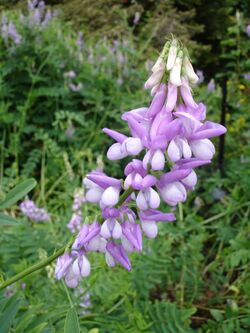Biology:Inverted repeat-lacking clade
| Inverted repeat-lacking clade | |
|---|---|

| |
| Galega officinalis | |
| Scientific classification | |
| Kingdom: | Plantae |
| Clade: | Tracheophytes |
| Clade: | Angiosperms |
| Clade: | Eudicots |
| Clade: | Rosids |
| Order: | Fabales |
| Family: | Fabaceae |
| Subfamily: | Faboideae |
| Clade: | Meso-Papilionoideae |
| Clade: | Non-protein amino acid-accumulating clade |
| Clade: | Hologalegina |
| Clade: | Inverted repeat-lacking clade (Wojciechowski et al. 2000,[1] 2004[2]) Wojciechowski 2013[3] |
| Tribes[1][5] | |
| |
| Synonyms | |
| |
The inverted repeat-lacking clade (IRLC) is a monophyletic clade of the flowering plant subfamily Faboideae (or Papilionaceae). Faboideae includes the majority of agriculturally-cultivated legumes. The name of this clade is informal and is not assumed to have any particular taxonomic rank like the names authorized by the ICBN or the ICPN.[3] The clade is characterized by the loss of one of the two 25-kb inverted repeats in the plastid genome that are found in most land plants.[6] It is consistently resolved in molecular phylogenies.[1][2][5][6][7][8][9][10][11][12][13] The clade is predicted to have diverged from the other legume lineages 39.0±2.4 million years ago (in the Eocene).[14] It includes several large, temperate genera such as Astragalus L., Hedysarum L., Medicago L., Oxytropis DC., Swainsona Salisb., and Trifolium L..
Description
This clade is composed of five traditional tribes (Cicereae Alef., Fabeae Rchb., Galegeae Dumort., Hedysareae DC., Trifolieae Endl.) and several genera that were traditionally placed in the tribe Millettieae: Afgekia, Callerya, Endosamara, Sarcodum, Wisteria, and possibly Antheroporum.[3] The first five of these genera have been transferred to the tribe Wisterieae, so that as revised, the tribe Millettieae falls outside the IRLC clade.[4] The clade is defined as:
"The most inclusive crown clade exhibiting the structural mutation in the plastid genome (loss of one copy of the ~25-kb inverted repeat region) homologous with that found in Galega officinalis L. 1753, Glycyrrhiza lepidota Nuttall 1813, and Vicia faba L., where these taxa are extant species included in the crown clade defined by this name."[3]
Uses
This clade includes edible plants such as garden peas, lentils, chickpeas, licorice, alfafa, among others.
References
- ↑ 1.0 1.1 1.2 "Molecular phylogeny of the “temperate herbaceous tribes” of papilionoid legumes: A supertree approach". Advances in Legume Systematics, Part 9. Kew, UK: Royal Botanic Gardens. 2000. pp. 277–298. ISBN 184246017X. http://www.public.asu.edu/~mfwojci/pdfs/WojoALS2000.pdf.
- ↑ 2.0 2.1 "A phylogeny of legumes (Leguminosae) based on analysis of the plastid matK gene resolves many well-supported subclades within the family". Am J Bot 91 (11): 1846–1862. 2004. doi:10.3732/ajb.91.11.1846. PMID 21652332.
- ↑ 3.0 3.1 3.2 3.3 Wojciechowski MF. (2013). "Towards a new classification of Leguminosae: Naming clades using non-Linnaean phylogenetic nomenclature". S Afr J Bot 89: 85–93. doi:10.1016/j.sajb.2013.06.017.
- ↑ 4.0 4.1 Compton, James A.; Schrire, Brian D.; Könyves3, Kálmán; Forest, Félix; Malakasi, Panagiota; Sawai Mattapha; Sirichamorn, Yotsawate (2019). "The Callerya Group redefined and Tribe Wisterieae (Fabaceae) emended based on morphology and data from nuclear and chloroplast DNA sequences". PhytoKeys (125): 1–112. doi:10.3897/phytokeys.125.34877. PMID 31303810.
- ↑ 5.0 5.1 "Reconstructing the deep-branching relationships of the papilionoid legumes". S Afr J Bot 89: 58–75. 2013. doi:10.1016/j.sajb.2013.05.001.
- ↑ 6.0 6.1 "Evolutionary significance of the loss of the chloroplast-DNA inverted repeat in the Leguminosae subfamily Papilionoideae". Evolution 44 (2): 390–402. 1990. doi:10.2307/2409416. PMID 28564377. https://deepblue.lib.umich.edu/bitstream/2027.42/137404/1/evo05207.pdf.
- ↑ Liston A. (1995). "Use of the polymerase chain reaction to survey for the loss of the inverted repeat in the legume chloroplast genome". Advances in Legume Systematics, Part 7: Phylogeny. Kew, UK: Royal Botanic Gardens. pp. 31–40. ISBN 0947643796. http://www.kewbooks.com/asps/ShowDetails.asp?id=81.
- ↑ "Molecular evolution of the Leguminosae: Phylogeny of the three subfamilies based on rbcL-sequences". Biochem Syst Ecol 24 (5): 365–378. 1996. doi:10.1016/0305-1978(96)00032-4.
- ↑ "Diversification rates in a temperate legume clade: Are there "so many species" of Astragalus (Fabaceae)?". Am J Bot 83 (11): 1488–1502. 1996. doi:10.2307/2446103.
- ↑ "A phylogeny of the chloroplast gene rbcL in the Leguminosae: Taxonomic correlations and insights into the evolution of nodulation". Am J Bot 84 (4): 541–554. 1997. doi:10.2307/2446030. PMID 21708606.
- ↑ "Phylogenetic relationships of basal papilionoid legumes based upon sequences of the chloroplast trnL intron". Syst Bot 26 (3): 537–556. 2001. doi:10.1043/0363-6445-26.3.537. http://www.bioone.org/doi/abs/10.1043/0363-6445-26.3.537.
- ↑ "Phylogenetic supermatrix analysis of GenBank sequences from 2228 papilionoid legumes". Syst Biol 55 (5): 818–836. 2006. doi:10.1080/10635150600999150. PMID 17060202.
- ↑ "Revisiting the phylogeny of papilionoid legumes: New insights from comprehensively sampled early-branching lineages". Am J Bot 99 (12): 1991–2013. 2012. doi:10.3732/ajb.1200380. PMID 23221500.
- ↑ "Evolutionary rates analysis of Leguminosae implicates a rapid diversification of lineages during the tertiary". Syst Biol 54 (4): 575–94. 2005. doi:10.1080/10635150590947131. PMID 16085576.
External links
Wikidata ☰ Q16983603 entry
 |

